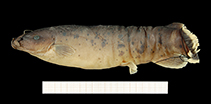| Family: |
Malapteruridae (Electric catfishes) |
| Max. size: |
21.2 cm SL (male/unsexed) |
| Environment: |
demersal; freshwater, |
| Distribution: |
Africa: endemic to the Kogon River, Guinea (Ref. 44050, 57130). |
| Diagnosis: |
Dorsal spines (total): -0; Dorsal soft rays (total): -0; Anal spines: -0; Anal soft rays: 8-10; Vertebrae: 38-40. Diagnosis: body elongate and cylindrical; tooth patches narrow; vertically based pectoral fin positioned at body mid-depth; caudal bar frequently extends a narrow band along the body mid-depth, dividing the pale interspace and joining the saddle and caudal bar; medial portion of pelvic fin dark with a well-defined pale rim; caudal saddle and bar pattern more prominent in juveniles and young, the darkened pelvic fin more apparent in larger specimens (Ref. 44050).
Description: body elongate and fusiform; head slightly depressed; eyes large and lateral; jaws equal; 16-18 abdominal vertebrae; 21-23 caudal vertebrae; 19 caudal-fin rays (arrangement usually ii-7-8-ii, but also ii-6-8-ii and iii-7-8-ii) (Ref. 44050, 57130).
Coloration: body and head strongly bicolored; dorsum and flank dark grey, with venter sometimes dusky, especially on the underside of the head, but always much lighter than dorsum; dorsum and flank marked by scattered spots, few larger than 2-3 times an eye diameter, with a few scattered small spots on the venter; caudal saddle and bar pattern well developed and dark; saddle covers most of flank, but stops short of anal-fin base; pale interspace is bright in young; caudal bar wedge-shaped, usually with an anterior projection along the body mid-depth that often extends anteriad and merges with the saddle, completely dividing the pale interspace; definition of saddle and bar decreases with size, only faintly visible at 140mm SL; anal fin darkly pigmented throughout, except for pale distal rim; caudal fin in adults solidly pigmented throughout, except for a pale distal margin; pale basal crescent in caudal fin present in juveniles and young; pectoral fin dusky in adults, largely clear in juveniles; pelvic fin bears a sharply defined pigmented medial section, which darkens with age (Ref. 44050). |
| Biology: |
|
| IUCN Red List Status: |
Vulnerable (VU); Date assessed: 23 April 2020 (B1ab(i,ii,iii)+2ab(i,ii,iii)) Ref. (130435)
|
| Threat to humans: |
harmless |
Source and more info: www.fishbase.org. For personal, classroom, and other internal use only. Not for publication.

